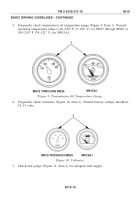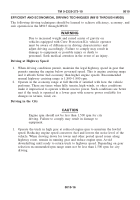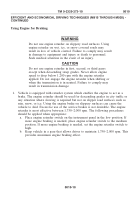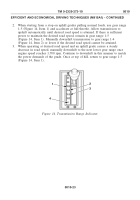TM-9-2320-273-10 - Page 186 of 452
EFFICIENT AND ECONOMICAL DRIVING TECHNIQUES (M915A1)
The following driving techniques should be learned to achieve efficiency, economy, and
safe operation in the M915A1.
WARNING
Due to increased weight and raised center of gravity on
vehicles equipped with Crew Protection Kit, vehicle operator
must be aware of differences in driving characteristics and
adjust driving accordingly. Failure to comply may result in
damage to equipment or possible injury or death to
personnel. Seek medical attention in the event of an injury.
Driving at Highway Speeds
NOTE
The transmission lockup clutch automatically engages after
load is rolling and torque demand is low, and automatically
disengages at lower tractor speeds. When engaged, increased
fuel economy is achieved at highway cruising speeds.
1. Learn to identify transmission lockup clutch engagement/disengagement. Lockup
engagement is felt similar to transmission gear range shifts. In addition, a slight
change in engine sound can be heard when lockup occurs, due to a drop in rpm.
With experience it is possible to tell the difference between gear range changes
and lockup engagement/disengagement.
2. When driving conditions permit, maintain legal highway speed in gear range 1-5
(Figure 13, Item 1). Gear range 1-5 (Figure 13, Item 1) permits running the
engine below its governed speed (preferably 10–20 percent below governed
speed), and affords better fuel economy than at higher engine speeds. The
recommended normal highway cruising range is 1,800–1,900 rpm.
TM 9-2320-273-10
0010
0010-20
Back to Top




















